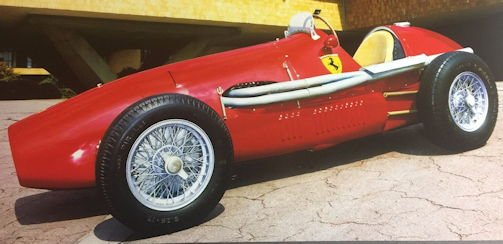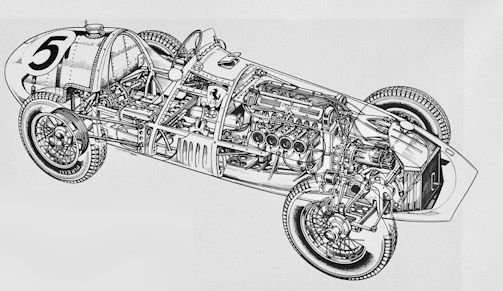Ferrari 500 F2
 |
|
|
Builder |
Ferrari |
|
Class |
Race Car |
|
Designed by |
Aurelio Lampredi |
|
Chassis |
tubular spars and crosspieces |
|
Motor |
4 cylinders in line of 1984 cm³ |
|
Transmission |
4-speed manual gearbox + non-synchronized RM mounted in block with the ZF self-locking differential; rear-wheel Drive |
|
Length |
3800 mm |
|
Length |
1400 mm |
|
Height |
1050 mm |
|
Step |
2160 mm |
|
Weight |
560kg |
|
Fuel |
Shell |
|
Tyres |
Pirelli , Englebert , Dunlop , Avon |
The Ferrari 500 was a Formula racing car , built and used by the Scuderia Ferrari in the 1950s .
History
1952 changed the conditions, after which the World Championship races of the largest Monoposto race series were held. Ferrari responded quickly and had Aurelio Lampredi develop new 4-cylinder engines. The 2-liter version was used in the new Ferrari 500, a race car that dominated the Formula 2 race for two years. In the debut, the Gran Premio di Siracusa 1952, four 500s took the first four places. In 1953, Mike Hawthorn celebrated his first victory in France in a Grand Prix race also on a Ferrari 500.i raced in the 1952 , 1953 , 1954 and 1955 Formula 1 world championship . It was also the first Ferrari to be conceived with an engine other than 12 cylinders. With this car Alberto Ascari won the world drivers' title in 1952 and 1953. The name of the car "500" represents the displacement of 500 cc per cylinder of the engine (500 cc x 4 cylinders = 2,000 cc)
The factory engines, with double overhead camshaft, made up to 180 hp. To achieve a better weight distribution, the engine in the tubular frame was moved further to the rear. The suspension was taken over by the Ferrari 375F1 . With a wheelbase of 2160 mm, a length of almost four meters and a height of 1050 mm, the 500 was an extremely agile monoposto with a curb weight of 560 kg. Alberto Ascari won with the Ferrari 500 twice, 1952 and 1953, the drivers' world championship. Only the private drivers were opponents. However, their 500s were delivered with a speed limit and the engines had significantly less power than the factory cars. First Juan Manuel Fangio finished the end of the season 1953 with his victory on a Maserati A6GCM at the Italian Grand Prix the winning streak of the Ferrari 500.
The debut of the 500 F2 took place at the 1951 Modena Grand Prix (a race not valid for the world championship) with Ascari and Villoresi at the wheel . The former took victory ahead of José Froilán González , who was driving a 166 F2 , while the latter was forced to retire.
At the end of 1951, with Alfa Romeo 's withdrawal from racing, the F1 starting grid featured few good cars. For this reason, before the start of the 1952 season, the FIA announced that for that year and the following it would be allowed to race with Formula 2 cars , a category which saw the participation of teams such as Gordini , Cooper , Maserati and Ferrari itself. So, one of the few F1 teams prepared for the new needs was Ferrari, which was already working on the new 500 F2 at the beginning of 1951.
Instead of modifying the 12-cylinder used on the 166 F2 or on the previous Formula 1s, Aurelio Lampredi decided to design an unprecedented four-cylinder from scratch, a split considered more suitable for the displacement of 2,000 cm³ and that of 2,500 cm³, which would come into force in 1954, both by Ferrari and Lampredi himself. Already in the spring of 1951 the 2,000 cm³ engine was ready and carried out its first bench tests. The first tests revealed its greater efficiency compared to a 12-cylinder of the same displacement: it had more torque, weighed 45 kg less, had a 15% improved weight-power ratio and could count on 65% fewer moving parts. Power was 165 HP at 7,000 rpm, but would reach 200 with modifications made over time. The smaller size of the engine compared to a 12-cylinder also allowed for better weight distribution thanks also to the gearbox housed under the driver's seat and the magnets placed immediately behind the front axle.
PERFORMANCE
- Top speed 240 km
- Power to weight ratio 3.4 kg/hp (3.0) in 1953)
- Maximum power 165 hp at 7000rpm
- Specific power 83.1 hp/litre 93.2 in 1953
In the two years that saw it as a protagonist in the world championship, the 500 F2 underwent very few changes. Apart from the engine which reached 200 HP, the most important modification consisted of a lengthened nose for use on fast circuits to obtain better aerodynamic penetration. But apart from these minimal modifications, the car never underwent changes as it was in fact a balanced object in both form and substance.
While the number '500' in a Formula 3 Cooper's title indicates that it had an engine of only 500 cc, the figures in this Ferrari's title form part of the Modenese company's unusual car classification system, used for many years. Ferrari classified their cars by the number of cubic centimetres of one engine cylinder.
Thus, the Ferrari 500 of 1952—53 was a two-litre four-cylinder Formula 2 car, with each cylinder displacing 500 cc: 500 cc x 2000 cc. Similarly, the earlier 1.5-litre supercharged V 12 Tipo 125 car had had a unit cylinder displacement of 125 cc: 125 cc x 1500 cc. Aurelio Lampredi had developed the simple four-cylinder twin-overhead-camshaft two-litre engine for Formula 2 racing in 1950 and it was installed in a conventional twin-tube chassis frame with transverse leaf-spring independent front suspension and a De Dior axle layout at the rear. When 1.5-litre super charged Grand Prix competition died at the end of 1951, organizers were allowed freedom
by the International governing body—the Commission Sportive Internationale to throw their World Championship Grand Prix races open to unblown two-litre Formula 2 cars. Ferrari, wily as ever, had a well-proven design ready to go. With the 90mm 78 mm, 1980 cc, 170bhp Ferrari 500, Alberto Ascari proved virtually unbeatable in these two seasons, taking two successive Drivers' World Championship titles.
In 1952 he won every Grand Prix he started, six of them, and in 1953 he won five times in eight starts. The only major Grand Prix he did not contest in 1952 fell to team-mate Piero Taruffl in a sister Ferrari 500 and in 1953 newcomer Mike Hawthorn won the French Grand Prix and Dr Farina the German event for the Prancing Horse team.
It took Fangio to break Ferrari's stranglehold by winning the last two-litre Grand Prix, at Monza at the end of the 1953 season.
Add to this magnificent success story non-Championship race wins at Syracuse, Marseilles, Saint-Gaudens, La Baule, Pau and Bordeaux, and you can appreciate how the news of another 'Ascari, Ferrari' victory became repetitious in those two remarkable years.

Technical
-
Ferrari 500 F2 Technical details and specifications (1952-1953)
ENGINE
front, longitudinal, four cylinders in line
Bore and stroke 90x78 mm
Total cubic capacity 1984.86
Valve gear twin overhead camshafts
Number of valves two per cylinder
Compression ratio 11.5:1 (13:1 in 1953)
Fuel feed four Weber 45 DOE carburettors (two Weber 50 DCOA in 1953)
Ignition double, two magnetos
Coolant water
Lubrication drum sumpTRANSMISSION
Rear-wheel drive
Clutch multi-disc
Gearbox four speeds reverse en bloc with differentialCHASSIS BODY:
Single-seater
longitudinal and cross membersSUSPENSION:
Front suspension
independent, double wishbones, transverse semi-elliptic spring Houdaille dampers
Rear suspension
De Dion axle. transverse semi-elliptic spring Houdaille dampersBRAKES:
drum front and rearSTEERING:
worm and sectorCAPACITIES:
Fuel tank 150 litresWHEELS TYRES:
Tyres front/ rear 525-16/6.00-16DIMENSIONS AND WEIGHT
Wheelbase 2160 mm
Track front/ rear 1278/1250 mm
Length 3988 mm
Width 1402 mm
Height 1050 mm
Kerb weight 560 kg© Motor car History
